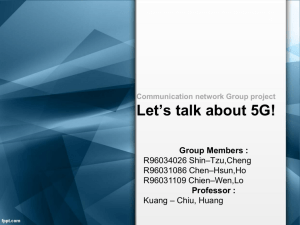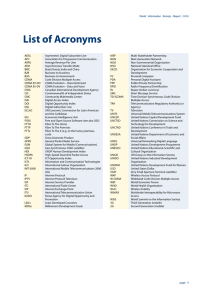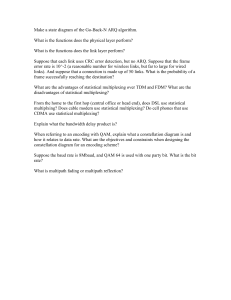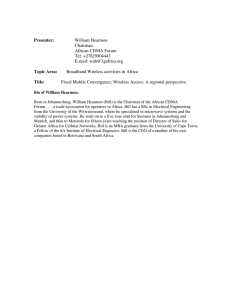Document 13289179
advertisement
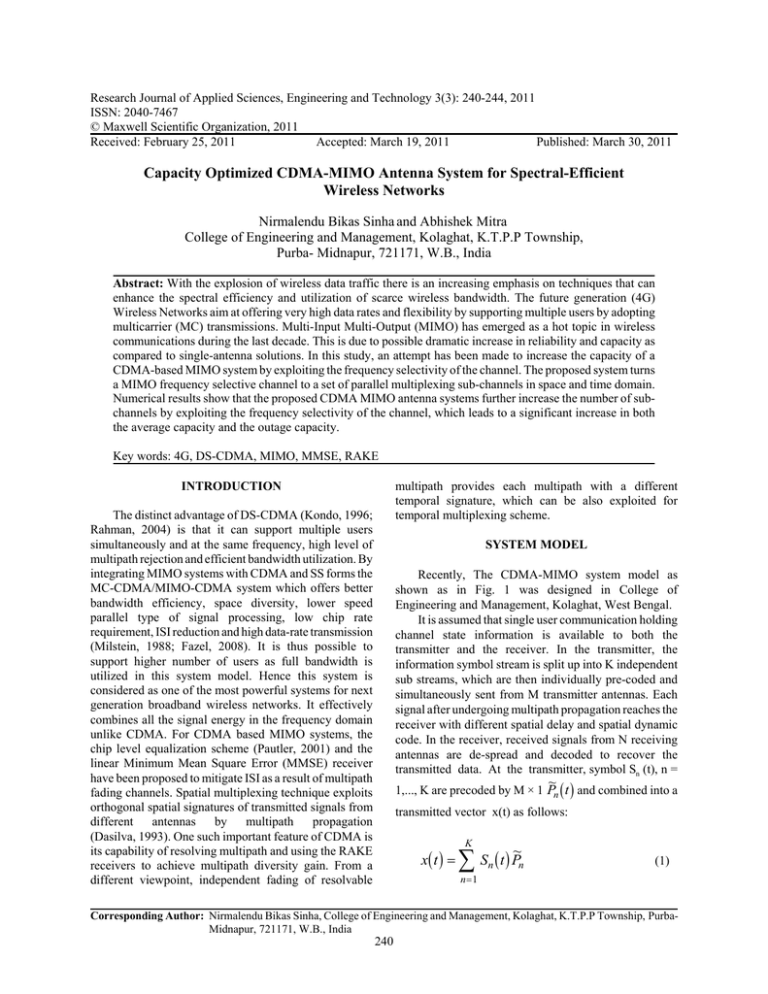
Research Journal of Applied Sciences, Engineering and Technology 3(3): 240-244, 2011 ISSN: 2040-7467 © Maxwell Scientific Organization, 2011 Received: February 25, 2011 Accepted: March 19, 2011 Published: March 30, 2011 Capacity Optimized CDMA-MIMO Antenna System for Spectral-Efficient Wireless Networks Nirmalendu Bikas Sinha and Abhishek Mitra College of Engineering and Management, Kolaghat, K.T.P.P Township, Purba- Midnapur, 721171, W.B., India Abstract: With the explosion of wireless data traffic there is an increasing emphasis on techniques that can enhance the spectral efficiency and utilization of scarce wireless bandwidth. The future generation (4G) Wireless Networks aim at offering very high data rates and flexibility by supporting multiple users by adopting multicarrier (MC) transmissions. Multi-Input Multi-Output (MIMO) has emerged as a hot topic in wireless communications during the last decade. This is due to possible dramatic increase in reliability and capacity as compared to single-antenna solutions. In this study, an attempt has been made to increase the capacity of a CDMA-based MIMO system by exploiting the frequency selectivity of the channel. The proposed system turns a MIMO frequency selective channel to a set of parallel multiplexing sub-channels in space and time domain. Numerical results show that the proposed CDMA MIMO antenna systems further increase the number of subchannels by exploiting the frequency selectivity of the channel, which leads to a significant increase in both the average capacity and the outage capacity. Key words: 4G, DS-CDMA, MIMO, MMSE, RAKE INTRODUCTION multipath provides each multipath with a different temporal signature, which can be also exploited for temporal multiplexing scheme. The distinct advantage of DS-CDMA (Kondo, 1996; Rahman, 2004) is that it can support multiple users simultaneously and at the same frequency, high level of multipath rejection and efficient bandwidth utilization. By integrating MIMO systems with CDMA and SS forms the MC-CDMA/MIMO-CDMA system which offers better bandwidth efficiency, space diversity, lower speed parallel type of signal processing, low chip rate requirement, ISI reduction and high data-rate transmission (Milstein, 1988; Fazel, 2008). It is thus possible to support higher number of users as full bandwidth is utilized in this system model. Hence this system is considered as one of the most powerful systems for next generation broadband wireless networks. It effectively combines all the signal energy in the frequency domain unlike CDMA. For CDMA based MIMO systems, the chip level equalization scheme (Pautler, 2001) and the linear Minimum Mean Square Error (MMSE) receiver have been proposed to mitigate ISI as a result of multipath fading channels. Spatial multiplexing technique exploits orthogonal spatial signatures of transmitted signals from different antennas by multipath propagation (Dasilva, 1993). One such important feature of CDMA is its capability of resolving multipath and using the RAKE receivers to achieve multipath diversity gain. From a different viewpoint, independent fading of resolvable SYSTEM MODEL Recently, The CDMA-MIMO system model as shown as in Fig. 1 was designed in College of Engineering and Management, Kolaghat, West Bengal. It is assumed that single user communication holding channel state information is available to both the transmitter and the receiver. In the transmitter, the information symbol stream is split up into K independent sub streams, which are then individually pre-coded and simultaneously sent from M transmitter antennas. Each signal after undergoing multipath propagation reaches the receiver with different spatial delay and spatial dynamic code. In the receiver, received signals from N receiving antennas are de-spread and decoded to recover the transmitted data. At the transmitter, symbol Sn (t), n = 1,..., K are precoded by M × 1 Pn ( t ) and combined into a ~ transmitted vector x(t) as follows: x( t ) = K ∑ S (t) P ~ n n (1) n =1 Corresponding Author: Nirmalendu Bikas Sinha, College of Engineering and Management, Kolaghat, K.T.P.P Township, PurbaMidnapur, 721171, W.B., India 240 Res. J. Appl. Sci. Eng. Technol., 3(3): 240-244, 2011 Fig. 1: CDMA-MIMO system model where, K is the number of symbols simultaneously transmitted via parallel sub channels. ~ p is the linear precoder of the proposed system. r( t ) = (2) yi ( m) = K = l C C (4) NTC ∑ n =1 mT + iTC ∫( m− 1) T + iTC r ( t ) a( t − iTC ) dt (5) L ⎛ ~ (( l − i ) TC ) H P~ ⎞⎟ + n ( m) ⎫⎪ Tn bn ( m) ⎜ Hi Pn + ρn l n ⎜ ⎟ i ⎪ NTC ⎝ ⎠ l = 1, l ≠ i ⎬ (6) mT ⎪ where bn ( m) = bn ( t ) dt ⎪ ( m− 1)T ⎭ ∑ ∫ ni(m) is N×1 noise vector of the additive white Gaussian noise with variance σ n2 . The desired signal part of the Eq. (15) is composed of two parts. The first is the desired signal of the matched RAKE finger and the second represents the signal smeared into the other RAKE fingers, which will be considered as ISI for a conventional RAKE receiver. MIMO CDMA system can be transformed into an equivalent system consisting of min (M, L, N) SISO sub-channels, which are loosely coupled with each other. The proposed linear pre-coder and decoder increases the number of parallel sub channels up to min(M, L, N) by exploiting frequency selectivity of the channel. Generally, for downlink communications, the value of N is smaller than M. Because of the constraint on L ∑ H δ ( t − lT ) l The N × 1 output vector yi(m) consists of the output symbols of the N parallel PN correlator matched to the ith path becomes: where, Tn denotes the transmitted signal power, bn(t) is the data signal for nth sub channel consisting of independent and identically distributed (i.i.d) data bits with duration x which takes on the value of ±1 with equal probability. Likewise, a(t) is the pseudo random sequence with ± 1 chips of duration Tc and code length N = x/TC. The chip waveform is assumed to be rectangular. Transmission from M transmit antennas to N receive antennas each with L Rake fingers. The transmitted signal goes through the frequency-selective fading channel. A Power Delay Profile (PDP) with maximum excess delay LTC is taken. By the tapped delay line model: h( t ) = ∑ H x( t − lT ) + n( t ) l =1 The baseband equivalent transmitted signal for the nth sub channel is denoted as: Sn ( t ) = Tn bn ( t ) a( t ) L (3) l =1 The N×M complex valued random matrices Hl denoting lth tap of the stochastic matrix-valued channel impulse response. Throughout this section, we assume that the elements of the Hl are uncorrelated circularly symmetric complex Gaussian random variables. The received signal at the mobile station (MS) is shown as: 241 Res. J. Appl. Sci. Eng. Technol., 3(3): 240-244, 2011 the physical size of MS, the number of sub channels is always limited to N as in case of previous CDMA MIMO systems in frequency selective fading channel (Pautler, 2001). On the other hand, the CDMA MIMO system which is newly developed by the author supports linear processing thereby increasing the number of parallel sub channels up to min (M, L, N) by exploiting frequency selectivity of fading channels. The increased number of multiplexing channels enhances the capacity of the system in favourable SNR conditions. The optimal power allocation by water-filling (WF) algorithm is derived as: ( βn = ξ − γ 1λ ) ∑ ⎞ ⎟ ⎟ K ∆λn ,i Pi + σ n2 ⎟ ⎠ i = 1, i ≠ n xTn λn Performance analysis of CDMA-MIMO system: The output capacity Cq is defined as prob [C > Cq] = 1 ! q. In this section, q is assumed to be 0.1. An exponentially decaying PDP model was used. The average power of the lth path is given by: (7) Ωl = Summing up the individual capacities (Viswanath, 1999) we get: C= 1 N ∑ K I n =1 K 1 N ∑ γn ∑ K i =1, i ≠ n ∆γ n,i ⎫ ⎪ ⎪ Ti x ∆γ n ,i = 2 ∆λn ,i = γ o βi λn,i ⎬ σn ⎪ T Tx γ o = σn2 ; β j = Tj ⎪ n ⎭ Tn x σ n2 ⎞ (8) ⎟ ⎟ + 1⎟ ⎠ Ωo = λn = γ o βn λn (9) K K =T (12) ∑ L l =1 Ωl (13) Figure 2 shows the average and the outage capacity of the proposed (M, N, L) CDMA -MIMO system with * = 0 and N = 16. It is observed that by fixing the number of transmitter antennas M to 4 and increasing the number of receiver sensors LN to 4 leads to an increase in the number of multiplexing sub-channels and hence an increase in the average and the output capacity. The additional degrees of freedom obtained by increasing L are exploited to extend the multiplexing domain to the space and time domain rather than to increase the diversity gain. As we increase SNR, the slope of outage capacity decreases because the coupling between multiplexing sub channels also increases. Thus, a rise of ISI leads to an increase in the variance of the capacity random variables which mainly affects the outage capacity. The influence of propagation parameters and system parameters on average capacity is studied and the beneficial impact of delay spread on capacity is demonstrated. The increase in delay paths results in (n is a function of transmitter powers Tn which is under the overall transmitted power constraint requiring that: ∑T , l = 1,..., L d is the decaying constant reflecting the frequency selectivity of the channel. S0 is a normalizing factor that keeps the average total transmitted power constant regardless of the number of paths and is given by: 8n is the Eigen value and C denotes the total capacity of the CDMA-MIMO system whereas the SNR of the kth sub-channel is represented by gn and )(n,i: γn = Ωo ~ ~ k ⎛ ⎜ ⎜1 + n =1 ⎜ ⎝ e(δ ( l − 1) ) where, S1 = , [trace (H1H1H)] = , [trace ( H1 H1H )] and (b ( m);b~( m)) = K (11) RESULTS AND DISCUSSION ~ ln bn ( m); bn ( m) = ⎛ ⎜ log 2 ⎜ 1 − ⎜ x ⎝ ) where, (·)+ denotes max (0, ·) and > is determined to satisfy the power constraint. The effective number of simultaneously transmitted symbols which represent the effective number of sub channels is the number of positive $n’s. Capacity: The total capacity of CDMA-MIMO system is the sum total of capacities of K sub-channels. The mutual capacity of each sub-channel is given by: ( o n (10) n =1 242 Res. J. Appl. Sci. Eng. Technol., 3(3): 240-244, 2011 CDMA-MIMO channel capacity vs. SNR performance 3.0 (4,2,1) Average (4,2,1) Outage (4,2,2) Average Channel capacity (bits/sec/Hz) 2.5 (4,2,2) Outage (4,4,1) Average 2.0 (4,4,1) Outage 1.5 1.0 0.5 5 10 15 25 20 30 SNR(dB) Fig. 2: Average and outage capacity of (M, N, L) as a function of SNR g0 for different antenna configurations and channel delay spreads when * = 0 and N = 16 Capacity vs. delay for MA-MIMO system 1.0 (4,2,1) Average (4,2,2) Average (4,4,1) Average 0.8 Delay 0.6 0.4 0.2 0 0 0.2 0.4 0.8 0.6 1.0 1.2 1.4 Capacity Fig. 3: Averege capacity (in bits/s/Hz) as a function of delay factors for various values of (M,N,L) increase of Eigen value through the channel. The number of delay paths as in Fig. 3 is proportional to the number of channels available from the transmitter to the receiver. Each delay path contributes an Eigen value. Hence, with the increase in the delay path for CDMA-MIMO system, the capacity of the channel increases. The proposed system exploits the additional degrees of freedom obtained by frequency-selective fading to increase the multiplexing gain, gain in the average capacity and outage capacity. It also provides a more robust, secure and spectral efficient system, reduction of distortion due to multipath propagation. In spite of these advantages, CDMA-MIMO system suffers from interferences which strictly limit its capacity. CONCLUSION A capacity optimized space-time linear pre-coder and decoder is designed. This exploits the additional degrees of freedom to increase the multiplexing gain to provide us a robust, secure and spectral efficient system. In spite of these advantages CDMA-MIMO system suffers from interferences which limit its capacity. The OFDM-MIMO system has been studied extensively in the past and is 243 Res. J. Appl. Sci. Eng. Technol., 3(3): 240-244, 2011 Fazel, K. and S. Kaiser, 2008. Multicarrier and Spread Spectrum Systems: From OFDM and MC-CDMA to LTE and WiMax. 2nd Edn., John Wiley and Sons, Ltd, Publication. Kondo, S. and B.L. Milstein 1996. Performance of multicarrier DS CDMA systems. IEEE Tran. Commun., 44(2): 238-246. Milstein, L.B., 1988. Interference rejection techniques in spread spectrum communications. Proc. IEEE, 76(6): 657-671. Pautler, J., M. Ahmed and K. Rohani, 2001. On application of multiple-input multiple-output antennas to CDMA cellular systems. Proceeding IEEE VTC 2001 Fall, pp: 1508-1512. Rahman, M. and P. Ernstrom, 2004. Repeaters for hotspot capacity in DSCDMA networks. IEEE Trans. Veh. Technol., 53(3): 626-633. Viswanath, P. and V. Anantharam, 1999. Optimal sequences and sum capacity of synchronous CDMA systems. IEEE Trans. Inform. Theory, 45(6): 1984-1991. found to satiate our requirements. Hence, it is important to draw up a comparison between the two systems which goes on to show that the channel capacity of MC-CDMA MIMO with perfect ICIC is always larger than or equal to that of OFDM-MIMO. ACKNOWLEDGMENT Authors thanks to the management of Maxwell Scientific Organization for financing the manuscript for publication. REFERENCES DaSilva, V. and E.S. Sousa, 1993. Performance of orthogonal CDMA codes for quasi-synchronous communication systems. Proceeding of IEEE International Conference on Universal Personal communications (ICUPC’93), Ottawa, Canada, pp: 995-999. 244

